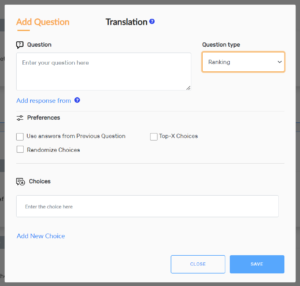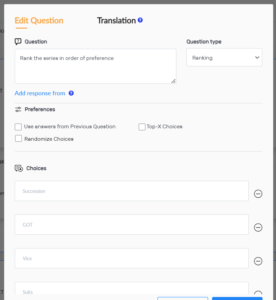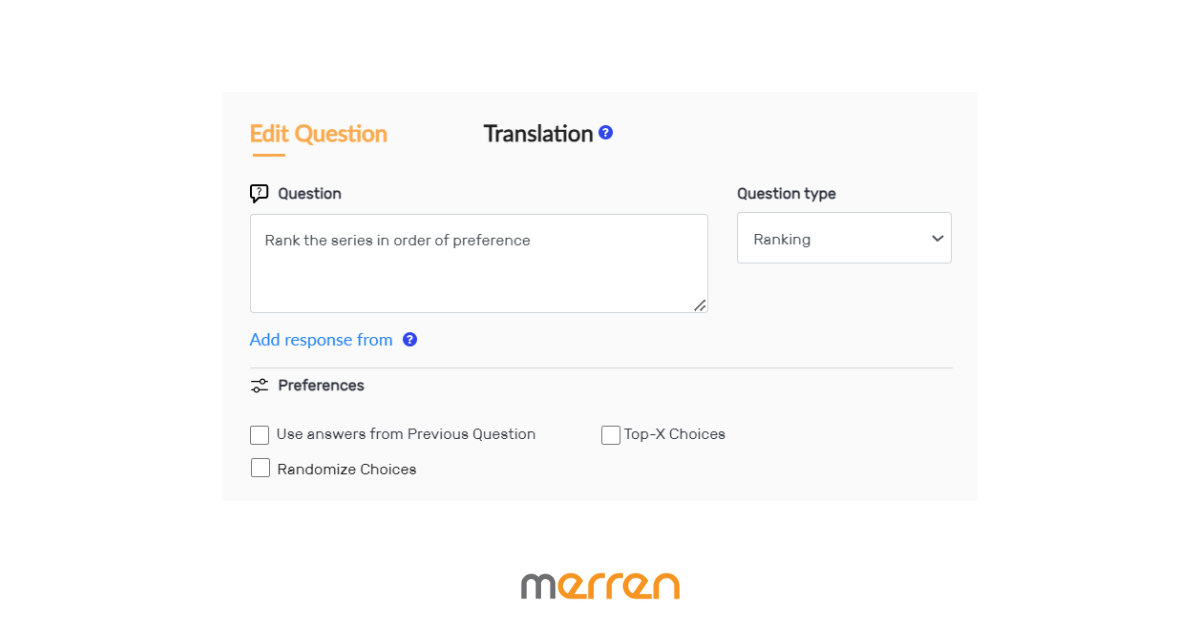Despite being closed-ended, Ranking questions are an integral part of a survey that allows customers and employees to rank items in order of importance. This method of seeking feedback can be used in different ways to make critical decisions. It can help a business understand metrics that work best and metrics that need immediate attention. If one is willing to focus on a 360 degree aspect of improvement within the organisation, ranking order questionnaires can offer interesting insights. In this blog, we will understand what is a ranking question and its types and the advantages and disadvantages of this type of question.
What are Ranking Questions?
Ranking questions are used in surveys to ask people to prioritize or rank a list of items according to their preferences. They can reveal insights into consumer behavior and decision-making, but it’s crucial to ensure the items being ranked are relevant within the context of the survey. When you visit a restaurant, the survey can ask patrons to rank items in order of their preferences. The survey can have questions based on food, service, ambiance, monetary value so that customers can rank what they liked the most.
Types of Ranking Questions
Ranking survey questions have a distinct difference from rating survey questions as they ask respondents to prioritize a set of choices in order of importance. This is different from rating each choice on a scale on the basis of “satisfied and unsatisfied” or on a “agree or disagree” scale. Ranking scales are commonly used in market research and online surveys as they provide valuable information about the target audience’s preferences and priorities. Paired comparison rankings and rank order scaling are also popular among researchers for measuring the level of agreement with certain statements related to the product features or brand functionalities.
For employees
Ranking survey questions are an effective way to gather feedback from employees. Two types of ranking questions that can be asked in a survey are paired comparison questions and rating scale questions. Open-ended ranking questions allow employees to give more detailed feedback. This data can be used by employers to make informed decisions regarding their employee benefits, policies, and programs.

For customers
For customers, one can use different types of ranking methods such as rank order scaling, paired comparison, and constant sum scaling. This makes it easy for survey respondents to rank a list of items in order of importance or preference. Using this distinct difference between functionality and common scale helps understand the target audience’s outlook towards product features. One can also send these ranking survey questions through email or integrate them into online surveys using the default checkbox or preview tab.
For consumer research
To gain useful insights into consumer behavior and decision-making processes in market research, one must understand two types of ranking questions: comparative and non-comparative. Comparative ranking questions require respondents to rank multiple items in order of preference or importance relative to one another. Non-comparative ranking questions involve respondents ranking a list of items based on their individual level of preference or importance. Both types help businesses determine what product features or characteristics are most valuable to their target audience without relying solely on ratings or reviews.
Advantages of Ranking Question in Surveys
The first advantage is that respondents are given a predefined set of options. In this way, they are forced to rank items in order of their preference. This is very specific and allows for clear comparison between metrics (for example a product will have multiple features. A few features might work best for the user). This helps in identifying the most favored or preferred option, enabling organizations to prioritize their actions accordingly.
This method of collecting feedback is a structured approach to data collection. By providing a standard format of the responses, it becomes easier to analyze and interpret the results. The data obtained from ranking questions can be quantified, allowing for statistical analysis and comparisons across different groups or segments. This is particularly useful when trying to identify patterns, trends, or significant differences in preferences or opinions.
Disadvantages of ranking question in surveys
Despite understanding a user’s preference, this method of seeking feedback can be closed-ended and does not allow open-ended expressions to explain the ranking order. It can be assumed that since an item may not be preferred on top, the feature or the item was not useful. Without a space to provide expression based feedback, there can be an assumption based conclusion from this type of survey.
The respondents are forced to make relative comparisons without a more nuanced response for the reason why something is ranked in order of choice. This prevents marketers from getting in-depth responses from a quantitative survey.
One should carefully consider the number of items being ranked, the complexity of the topic, and the potential trade-offs between response accuracy and respondent burden. Combining ranking questions with other question types can help mitigate these limitations and provide a more comprehensive understanding of the subjects under investigation.
How to analyze and interpret ranking question data
There is a step by step guideline on how to understand the ranking data. Here are some steps one can follow to make the best out of the results.
Average ranking
Average ranking is the average of all rankings given, providing a central tendency for preferences or choices being ranked. However, it may not account for the spread of rankings. Depending on context, median or mode may also be useful. Consider the purpose and variables before interpreting results.
Relative ranking
Compare the ranks of different items within individual responses. Look for consistent patterns or discrepancies. For example, if Item A is consistently ranked higher than Item B across responses, it suggests a preference for Item A.

Top ranked items
These are the items that are always ranked the highest. These items are likely to be the most preferred or important according to the respondents.
Segmentation analysis
If you have segment respondents based on demographic factors, consider conducting segmentation analysis. Compare rankings based on different segments (e.g., age groups, gender, location) to identify any variations in preferences.
Visualization analysis
Consider using bar graphs, pie charts or heat maps to identify recurring ranking items to present the data in a clear manner. A visual way to segregate the data is a good way to identify trends and patterns that may not be immediately apparent in raw data.
Total response weight
In a ranking scale, the options are assigned with a numerical value based on its position in the list. Let us say there are 4 items and each has to be rated on a scale of 1 to 5. So the question can be posed as follows:
Item A- 2, Item B- 4, Item C- 1, Item D- 3. So the total response weight will be calculated as 2+4+1+3 which equals 10 (the sum of all the ranks). Total response weight can be used in a different context when it comes to different survey methods.
Tips for creating effective ranking question surveys
To create effective ranking survey questions, ensure clarity by limiting the number of items being ranked and using a consistent scale such as a numerical or Likert scale. Incorporate an “other” or “none of the above” option to increase flexibility in answers. Before sending out surveys, pre-test them with a small group to validate results. Use distinct differences in functionality like checkbox or radio button options while designing survey questions. It is advisable to analyze total response weight while interpreting data as it can help identify important choices among different items on a common scale.
Conclusion
Clients can easily push ranking survey methods via our Whatsapp surveys, interactive dynamic emailers or via Facebook messenger. They can also opt for a web based chat bot that is super fast and collects data at a speed. This ensures a high response rate for every marketer that uses Merren’s facilities. To get started today, sign up for a 14 day free trial and test our facilities to supercharge your customer feedback collection.





